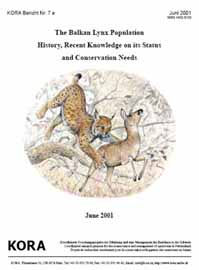|
ARD-BIOFOR IQC Consortium 2003. |
|
Report submitted to the United States Agency for International Development, exposing the context for environmental protection in Albania, especially with chapter on biodiversity, legal institutions and policy framework for conserving biodiversity, donor and NGO organizations working in Albania, and finally action plans and strategies applied in Albania. |
|
|
|
|
Breitenmoser-Wuersten, Ch. and Breitenmoser, U. (Eds.)
2001. The Balkan Lynx Population: History, Recent Knowledge on its Status and Conservation Needs. KORA Bericht 7: 1-39. KORA, Muri b. Bern. |
|
|
In March 2000, specialists from Albania, Bosnia-Herzegovina, Bulgaria, FR of Yugoslavia, FYR of Macedonia, and Greece, together with other European carnivore experts met in Plitvice National Park, Croatia, in order to put together the current knowledge on the status and distribution of the Balkan lynx population, which is now compiled in the papers of this volume. At the end of this report, we summarize the present information and identify the lack of knowledge. |
|
|
Breitenmoser-Wuersten_&_Breitenmoser_2001_Balkan_Lynx_Population.pdf |
|
Breitenmoser, U., Breitenmoser-Wuersten,
Ch., Okarma, H., Kaphegyi, T., Kaphegyi-Wallmann, U.,
and Mueller, U.M. 2000. |
| This action plan for the Eurasian lynx (Lynx lynx) addresses the conservation of the lynx on a pan-European level. Although the conservation and management units in Europe are the countries, the vast areas, over which viable populations of large carnivore species will expand requires for international concepts. The focus of all conservation and management activities must be the population. Regardless to the global status of a species, each population as an integral part of a local ecosystems should be preserved. All lynx populations in Europe expand over several countries, and in many cases, the national part of a population would not be viable by itself. This requires cross-border co-operation. The actions recommended refer to this pan- European approach, but are also listed for each single country. The objectives of the Action Plan address (1) policy and legislation; (2) species conservation and habitat protection; (3) conflicts with humans; (4) socio-economic incentives; (5) public awareness; and (6) monitoring and research. |
|
Breitenmoser_et_al_2000_Action_plan_for_the_Eurasian_Lynx.pdf |
|
Bego, F. and Koni, M. 1999. |
|
Report containing data on biological diversity in Albania, source and impacts of main threats, actual legislation and existing conservation programs, as well as data on future projects and action plans published by the Alliance "The Institute of Biological Research & Museum of Natural Sciences" in 1999. |
|
Bego_&_Koni_1999_Biodiversity_Strategy_and_Action_Plan_Albania.pdf |
|
Breitenmoser, U. and
Breitenmoser-Wuersten, Ch. 1990. Status of the Lynx in European countries: Extract of the chapters Albania, Bulgaria, Greece, FR of Yugoslavia. In: Status, conservation needs and reintroduction of the lynx (Lynx lynx) in Europe. Nature and Environment Series, No. 45: 11-33. Council of Europe Publishing, Strasbourg. |
| We will treat briefly the European countries with an existing or potential lynx population, in alphabetic order of their abbreviations. We use information and recommendations from our respondents. The “comment” represents our interpretation and opinion. |
|
Breitenmoser_&_Breitenmoser-Wuersten_1990_Status_in_European_countries.pdf |
|
von Arx, M., Breitenmoser-Wuersten, Ch.,
Zimmermann, F., and Breitenmoser, U. (Eds.). 2004. Status and conservation of the Eurasian lynx (Lynx lynx) in Europe in 2001. KORA Bericht 19: 1-330. KORA, Muri b. Bern. |
| The Action Plan for the Conservation of the Eurasian Lynx in Europe (Breitenmoser et al. 2000) was based on data up to 1995. This new report presents data up to 2001 (with some more recent observations), allowing seeing what has changed – and what has not. Different to prior status reports, we try an assessment of the populations. Obviously, conservation and management units are the countries (or even administrative units of the countries). The biological units, however, are the populations, and for a sound conservation and management, we must adjust national strategies to the viability of the population as a whole.Several of the European lynx populations or subpopulations are threatened, and some of them will only survive if neighbouring countries work closely together. This report hopefully helps to focus on the populations. |
